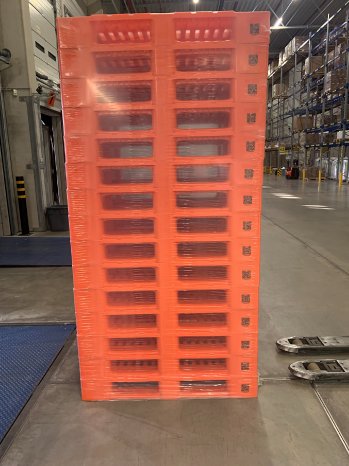Can plastic be more sustainable than wood? This seems to be the case with trans-o-flex Expressdienst. Since 2019, 30,000 grey plastic H1 pallets have proven their worth in daily use in trans-o-flex's internal goods handling and line haul operations. That is why the logistics service provider, which specialises in the pharmaceutical and health care, cosmetics, consumer goods electronics and other sensitive goods sectors, is now purchasing another 30,000 H1 pallets, this time in orange. "We have experienced extremely good results with the plastic pallets," says Wolfgang P. Albeck. "They last much longer and do not become heavier and less hygienic as they age, unlike wooden pallets. This makes them more sustainable overall and cheaper on the bottom line despite higher acquisition costs."
Therefore, in April, trans-o-flex will start making the orange plastic pallets available to customers from whom the company collects specific packages on pallets for various consignees. To do this, trans-o-flex enters into a special pallet exchange agreement with these customers. "It also saves customers money," says Albeck. "They pay a user fee that is less than the cost of wooden Euro pallets." In addition, the plastic pallets are more sustainable due to their advantages in weight and durability. According to a Fraunhofer study, an H1 pallet causes 50 per cent less CO2 emissions over its entire life cycle than an equivalent number of wooden pallets in the same period.
Even before procuring the first large batch of 30,000 H1 pallets, trans-o-flex had tested the load carriers for two years in long-distance transport between Hamburg and Hanover. Euro pallets made of wood withstood an average of eight cycles. They were then so damaged that they had to be replaced. In contrast, of the 30 H1 pallets used in daily transport between branches, only two were slightly damaged during the entire trial period. "The stability and longevity of this load carrier has been confirmed after the first roll-out, but these are by no means all the advantages," says Albeck.
Pharmaceutical customers refuse to accept dark wooden pallets
The plastic pallet, which is the same size as the wooden Euro pallet normally used, is much lighter. While a new wooden pallet weighs 24 kilos, its plastic counterpart weighs only 18 kilos. "This reduces the transport weight of a full articulated lorry by more than 200 kilos on each journey." In addition, a wooden pallet absorbs more and more moisture in the course of its short life and becomes even heavier. According to Albeck, there is another important aspect for the transport of medicines and other pharmaceuticals: "The H1 pallet also maintains its appearance and cleanliness. Wooden pallets, on the other hand, become dark and dirty through use." Pharmaceutical customers who hand over new light-coloured wooden pallets to trans-o-flex would therefore rightly complain if they received dark pallets back. Often the acceptance of such pallets would be refused. This is because only light-coloured pallets comply with quality class A, which is prescribed by the rules of Good Distribution Practice (GDP) for the transport of pharmaceutical goods. The plastic pallets are GDP-compliant as long as they are fit for use.



